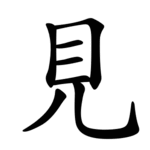Radical 147, also known as radical see (見部), represents the meaning "see" and is one of the 20 Kangxi radicals (out of a total of 214 radicals) composed of 7 strokes.
| 見 | ||
|---|---|---|
| ||
| 見 (U+898B) "see" | ||
| Pronunciations | ||
| Pinyin: | jiàn | |
| Bopomofo: | ㄐㄧㄢˋ | |
| Wade–Giles: | chien4 | |
| Cantonese Yale: | gin3 | |
| Jyutping: | gin3, jin6 | |
| Japanese Kana: | ケン ken (on'yomi) み-る mi-ru (kun'yomi) | |
| Sino-Korean: | 견 gyeon | |
| Names | ||
| Chinese name(s): | (Side) 見字旁/见字旁 jiànzìpáng (Bottom) 見字底/见字底 jiànzìdǐ | |
| Japanese name(s): | 見/みる miru | |
| Hangul: | 볼 bol | |
| Stroke order animation | ||
 | ||

In the Kangxi Dictionary, there are 161 characters (out of 49,030) that can be found under this radical.
The simplified form of the character 見 is written as 见 and is the 78th indexing component in the Table of Indexing Chinese Character Components primarily used in Simplified Chinese dictionaries published in mainland China. The traditional form 見 is listed as its associated indexing component. The simplified form of this radical character consists of 4 strokes.
Evolution
edit-
Oracle bone script character
-
Bronze script character
-
Large seal script character
-
Small seal script character
Derived characters
edit| Strokes | Characters (見) | Characters (见) |
|---|---|---|
| +0 | 見 | 见SC (=見) |
| +2 | 覌 (=觀) 覙 (=覶 / 診 -> 言) | 观SC (=觀) |
| +3 | 覍 覎 | 觃SC (=覎) |
| +4 | 規 覐 (=覺) 覑 覒 覓 覔 (=覓) | 规SC (=規) 觅SC (=覓) |
| +5 | 覕 覗 覘 覚JP (=覺) | 觇SC (=覘) 览SC (=覽) 觉SC (=覺) |
| +6 | 覛 覜 | 觊SC (=覬) |
| +7 | 覝 覞 覟 覠 覡 | 觋SC (=覡) |
| +8 | 覢 覣 覤 覥 | 觌SC (=覿) 觍 (=覥) |
| +9 | 覦 覧JP (=覽) 覨 覩 (=睹 -> 目) 親 | 觎SC (=覦) |
| +10 | 覫 覬 覭 覮 覯 | 觏SC (=覯) |
| +11 | 覰 覱 覲 観 (=觀) | 觐SC (=覲) 觑SC (=覷) |
| +12 | 覴 覵 覶 覷 覸 | |
| +13 | 覹 覺 覻 (=覰) | |
| +14 | 覼 (=覶) 覽 | |
| +15 | 覾 覿 | |
| +18 | 觀 |
Sinogram
editAs an independent sinogram It is one of the Kyōiku kanji or Kanji taught in elementary school in Japan.[1] It is a first grade kanji[1]
References
edit- ^ a b "The Kyoiku Kanji (教育漢字) - Kanshudo". www.kanshudo.com. Archived from the original on March 24, 2022. Retrieved 2023-05-06.
Further reading
edit- Fazzioli, Edoardo (1987). Chinese calligraphy : from pictograph to ideogram : the history of 214 essential Chinese/Japanese characters. calligraphy by Rebecca Hon Ko. New York: Abbeville Press. ISBN 0-89659-774-1.
- Lunde, Ken (Jan 5, 2009). "Appendix J: Japanese Character Sets" (PDF). CJKV Information Processing: Chinese, Japanese, Korean & Vietnamese Computing (Second ed.). Sebastopol, Calif.: O'Reilly Media. ISBN 978-0-596-51447-1.